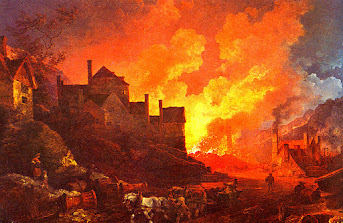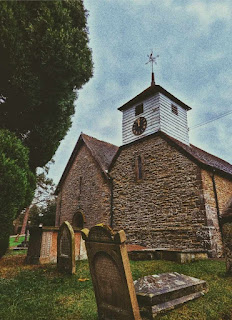‘A Coalbrookdale Suicide’- Some Thoughts
Whilst researching another project, I stumbled upon the following story, and since then- I’ve found it hard to get out of my head. The headline reads basic, in that matter-of-fact Victorian tone- ‘The Coalbrookdale Suicide- December 1842’. Certainly, it didn’t convey the full tragedy of the event, which I met upon reading. The suicide of William Maybury – described as a ‘youth of eighteen’ at the time of death is a heart-breaking piece of Coalbrookdale’s history, and it left me wanting to know more. I wanted to try and uncover the events that could lead to such a young man’s death to piece together the picture obscured by the fog of time. As I often do during my research, I became preoccupied with questions. Who was William, and why did the events unfold in such a way that evening? Sadly, many of these questions are still to be answered, which only motivates me to continue the search, and share his story. Though I have found William Maybury's death reported as far away as Sydney, New South Wales, I’ve found it hard to find anything about his life or discern much about the men who were with him on the night of his death. Nevertheless, I believe that William Maybury is important, and we must share this story to understand the impact it had on his community as well as its role in the industrial history of The Ironbridge Gorge. Though I cannot tell you about the person he was, I don’t want him to be forgotten.
Often when I engage with Shropshire’s history, I come across
accounts of tragic death, violence or suicide, and William Maybury’s suicide is
one which has definitely affected me, leaving me wishing someone could have
helped him. I am not a historian of psychiatry or mental illness, so I cannot discuss
the specifics of his condition, the best I can do is recount the story with empathy.
There is something so inconclusive about it, so groundless and the tragedy is
amplified by the public display of self-violence among peers. William Maybury
ended his life in one of the most violent ways imaginable- as we shall soon see,
which is as shocking today as it would have been to contemporary audiences. We
aren’t given any insight into the boy before his suicide, any of the
complexities and simplicities which made him who he was are lost to the past. I
wish we could be given some insight into him in happier times. There is
something about the phrase ‘a youth of eighteen’ which reminds us of how
much life he had left to live. This brings to mind another heart-breaking
suicide I’ve read about, that of a little girl. Almost a year after William Maybury’s
death in 1842, a child committed suicide in Ketley in 1843. The newspaper doesn’t
state her name or age- she is known simply as ‘James Colley’s daughter’. Certainly,
there would have been a time when people would have known who ‘James Colley’s
daughter’ was- but I think she deserved to be named. The newspaper states
that her mother sent her to get coal from the local pits, but she didn’t return
at her usual time. Her brother saw her on the way back from work and told her she’d
get ‘a good hiding’ for being late. The thought of being physically
chastised terrified the girl, so she took off her bonnet and pinafore then
threw herself into the pit. After a search, her body was recovered from a 200-foot-deep
pit, and her remains were in a very bad way. Its horrible to imagine the fear
this poor little girl went through to think that death was more of an option
that facing those who waited for her at home. This is a sad example of the
realities for many growing up during this period. It’s hard not to get emotional
when imagining that little bonnet and pinafore, left on the ground for adults
to find. It’s as if she believed her clothing had more value than her life. The idea of such ill treatment saddens me, and
you cannot help but think about all the life she was yet to live. Perhaps William
had been exposed to similar fear, we can only speculate. Let us turn to William Maybury’s suicide now, as
recounted in various newspapers.
Its worthy of note that Coalbrookdale is a village in the
Ironbridge Gorge- Shropshire. Historically it has played a significant part in the
development of Iron ore smelting. Its landscape was dominated by blast
furnaces, roaring forges, smithies, and busy factories- which caused the whole
gorge to glow red with the throngs of industry. This was the world William
would have been familiar with, the place in which he called home.
It is said that William Maybury had been doing some work for
an engineer known as William Jenks at the local forge, with David Williams (described
only as an elderly man) his father and a man called John Salisbury. The payment
for this work had been ‘over two gallon of ale’ which after a long day
at work the men decided to settle down in the forge and drink together. They
were drinking amongst themselves and seemingly having a good time- as by 10 o’clock
they had drunk six quarts of ale. It was after this that William began to show
signs of being distressed and is described as taking ‘several liberties’
with John Salisbury- setting upon him and biting him, including biting at his
face and nose. David Williams and William’s father pulled him off of the man
and told him off – chiding him for his seemingly bizarre behaviour. After being
told off William became hysterical- bursting into tears and muttering things
under his breath. Before any of the men could find out what was wrong – William
Maybury seized the ‘gate’ -the mechanism which disengaged the water and caused
the machinery and hammer to move- and he threw himself under it. The hammer
struck several blows on poor William before the shocked men could shut the
machine down and aid him. John Salisbury was the first to act- but by the time
he turned the machine off it was clear that William Maybury’s skull was
crushed, and anything that William Maybury had been once was no more.
Little more is said about such a traumatic episode in
Coalbrookdale’s history. The inquest took place the following week at the end December
(meaning that if my dates are correct- William ended his life on Christmas Eve
– adding further tragedy to these sad events) in the large room of the Rodney
inn – Coalbrookdale. They concluded that William’s death had been caused by ‘Temporary
insanity’ and closed the case. But this wouldn’t have been the end of
things for William’s family and friends- or for the men who witnessed his
death. They would have spent a lifetime trying to understand that night,
reliving the events that took place in the forge. What does ‘Temporary
insanity’ really mean? It’s a phrase that poses more questions than it
answers. In a society ruled by the ‘stiff
upper lip’ coming to terms with such trauma would have been a stifling and
difficult process. They would have felt guilt, and shame and the myriad of
feelings associated with grief.
As I mentioned previously the story of William Maybury was
reported as far away as Sydney New South Wales under the headline ‘The
doings of Beer!’ In the ‘The Teetotaller and general newspaper’ which
focuses heavily on the evils of alcohol. I am not here to wax lyrical in such a
way- or say that alcohol was the sole cause of William taking his life, human
beings are complex, and he certainly deserves more dignity than being a stock
character or poster boy for the temperance movement. He was someone who was
loved, he had hopes and dreams and worked hard, but for whatever reason he felt
like he had to take such an extreme act. I find the whole affair incredibly sad.
By the end of the 19th century, people began to
understand that suicide was not so much an illness, but a symptom – a response
to the challenges posed by living in the modern world, and perhaps this is how
William’s death should be seen. We will likely never know what motivated him to
act in that moment, but it was a symptom of the challenges he saw when
navigating the world in which he lived. I wish there was more that I could say about
William Maybury. I feel like there is an empty space, a gap where the person
should be- that the narrative should somehow continue. It was such a quick,
violent end that it leaves one questioning how this could be. I imagine this is
a similar feeling to how the community felt- and no doubt such a profound loss would
have been felt for the rest of his family’s life.
In the 19th century - Coalbrookdale’s vast industrial landscape was often described as ‘Hell On Earth’ due to the sights and sounds of industry. Industrialisation changed the course of Shropshire’s history, catapulting the population into an age of iron, furnace, and kiln. This was a changing world of opportunity, illuminated by fierce furnace fires that never dimmed but also, It was a world of misfortune, lives marred by hard work and poverty. Perhaps for some people, including William, it felt more like hell than home.


.jpg)
Such a sad story of one so young ending their life for whatever reason. X
ReplyDelete